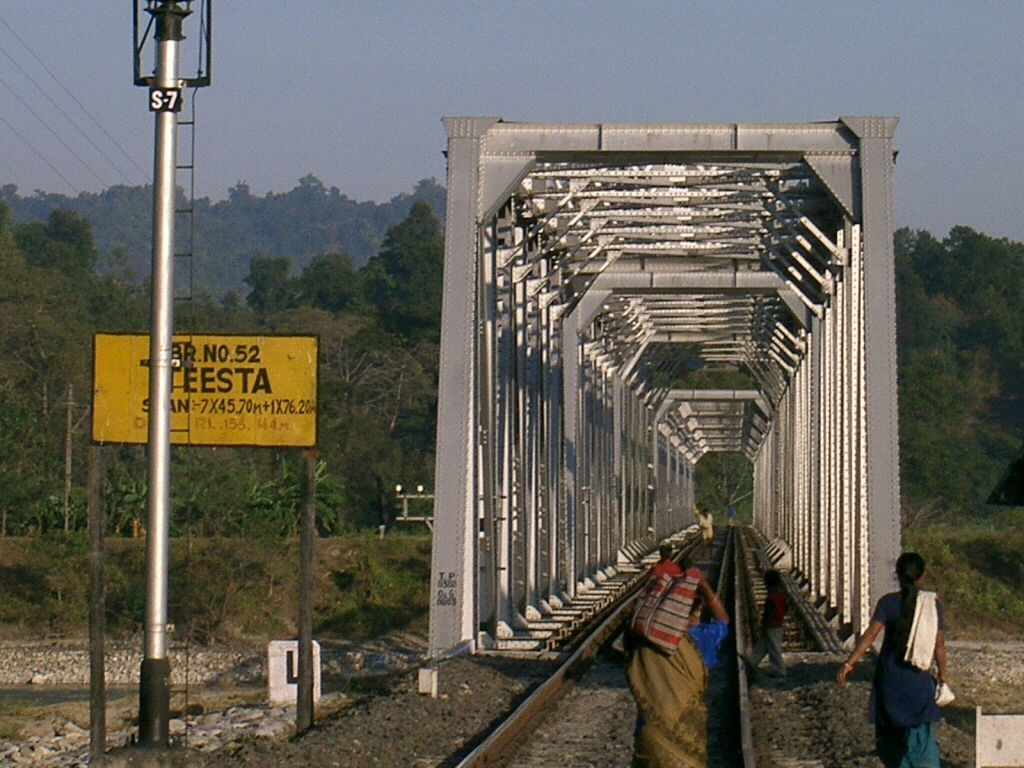|
New Jalpaiguri–Alipurduar–Samuktala Road Line
The New Jalpaiguri–Alipurduar–Samuktala Road line is a railway line that connects - Siliguri Junction with Alipurduar and in the Indian state of West Bengal. This railway line passes through the beautiful Doars region, which includes Mahananda Wildlife Sanctuary, Dooars-Terai tea gardens, Sevoke Railway Bridge, River Teesta, River Jaldhaka, River Torsha, Gorumara National Park, Buxa Tiger Reserve, Jaldapara National Park, Chapramari Wildlife Sanctuary, Chilapata Forests, Tunnels, Hills, Valleys etc. History Cooch Behar State Railway built the line between Geetaldaha, which connected to Lalmonirhat, and Jainti during 1893–1901. The Eastern Bengal Railway constructed the Hasimara–Alipurduar section during the period 1900–1910. The Bengal Dooars Railway also constructed certain lines in the area. Their longest line was from Lalmonirhat to the western Dooars. Those were metre-gauge railways. The Eastern Bengal Railway and the Assam Bengal Railway were merged during ... [...More Info...] [...Related Items...] OR: [Wikipedia] [Google] [Baidu] |
West Bengal
West Bengal (, Bengali: ''Poshchim Bongo'', , abbr. WB) is a state in the eastern portion of India. It is situated along the Bay of Bengal, along with a population of over 91 million inhabitants within an area of . West Bengal is the fourth-most populous and thirteenth-largest state by area in India, as well as the eighth-most populous country subdivision of the world. As a part of the Bengal region of the Indian subcontinent, it borders Bangladesh in the east, and Nepal and Bhutan in the north. It also borders the Indian states of Odisha, Jharkhand, Bihar, Sikkim and Assam. The state capital is Kolkata, the third-largest metropolis, and seventh largest city by population in India. West Bengal includes the Darjeeling Himalayan hill region, the Ganges delta, the Rarh region, the coastal Sundarbans and the Bay of Bengal. The state's main ethnic group are the Bengalis, with the Bengali Hindus forming the demographic majority. The area's early history featured a succession ... [...More Info...] [...Related Items...] OR: [Wikipedia] [Google] [Baidu] |
Chilapata Forests
The Chilapata Forest is a dense forest near Jaldapara National Park in Dooars, Alipurduar district, West Bengal, India. It is about 40 km from Alipurduar, and just a few minutes away from Hasimara town. Ecology The forest forms an elephant corridor between Jaldapara National Park and the Buxa Tiger Reserve, and is rich in wildlife. New species continue to be found. The forest used to be home to large Rhinoceros populations. In hunting expeditions in 1892-1904, in and around Chilapata Forest, the Maharajah of Cooch Behar recorded killing one rhino, injury of one, and sighting of over 14. Rhinos now are extremely rare. Indian leopards are still common. It is hoped that eco-tourism will provide a new source of income for the indigenous Rabha people, who now depend on the forest mainly for firewood. Tourism West Bengal State Forest Development Agency (WBSFDA) runs an eco-tourism resort at Kodalbasti, providing basic accommodation. One of the main attractions is the ruined "Na ... [...More Info...] [...Related Items...] OR: [Wikipedia] [Google] [Baidu] |
Partition Of India
The Partition of British India in 1947 was the Partition (politics), change of political borders and the division of other assets that accompanied the dissolution of the British Raj in South Asia and the creation of two independent dominions: Dominion of India, India and Dominion of Pakistan, Pakistan. The Dominion of India is today the India, Republic of India, and the Dominion of Pakistan—which at the time comprised two regions lying on either side of India—is now the Pakistan, Islamic Republic of Pakistan and the Bangladesh, People's Republic of Bangladesh. The partition was outlined in the Indian Independence Act 1947. The change of political borders notably included the division of two provinces of British India, Bengal Presidency, Bengal and Punjab Province (British India), Punjab. The majority Muslim districts in these provinces were awarded to Pakistan and the majority non-Muslim to India. The other assets that were divided included the British Indian Army, ... [...More Info...] [...Related Items...] OR: [Wikipedia] [Google] [Baidu] |
Bengal Assam Railway
The Assam Bengal Railway (ABR) was one of the pioneering railway companies in British India. Headquartered in Chittagong, it functioned from 1892 to 1942. History Assam Bengal Railway was incorporated in 1892 to serve British-owned tea plantations in Assam. Assam Bengal Railway started construction of a railway track on the eastern side of Bengal in 1891. A track between Chittagong and Comilla was opened to traffic in 1895. The Comilla-Akhaura-Kulaura-Badarpur section was opened in 1896–1898 and finally extended to Lumding in 1903. The Assam Bengal Railway constructed a branch line to Guwahati, connecting the city to the eastern line in 1900. The line was extended to Tinsukia in 1902 and it was also connected to Dibru-Sadiya Railway in 1903. In 1936, the company owned 205 locomotives, 588 coaches and 5922 goods wagons. On 1 January 1942 the Assam Bengal Railway combined with the Eastern Bengal Railway to form the Bengal and Assam Railway. [...More Info...] [...Related Items...] OR: [Wikipedia] [Google] [Baidu] |
Assam Bengal Railway
The Assam Bengal Railway (ABR) was one of the pioneering railway companies in British India. Headquartered in Chittagong, it functioned from 1892 to 1942. History Assam Bengal Railway was incorporated in 1892 to serve British-owned tea plantations in Assam. Assam Bengal Railway started construction of a railway track on the eastern side of Bengal in 1891. A track between Chittagong and Comilla was opened to traffic in 1895. The Comilla-Akhaura-Kulaura-Badarpur section was opened in 1896–1898 and finally extended to Lumding in 1903. The Assam Bengal Railway constructed a branch line to Guwahati, connecting the city to the eastern line in 1900. The line was extended to Tinsukia in 1902 and it was also connected to Dibru-Sadiya Railway in 1903. In 1936, the company owned 205 locomotives, 588 coaches and 5922 goods wagons. On 1 January 1942 the Assam Bengal Railway combined with the Eastern Bengal Railway to form the Bengal and Assam Railway. [...More Info...] [...Related Items...] OR: [Wikipedia] [Google] [Baidu] |
Lalmonirhat Sadar Upazila
Lalmonirhat Sadar ( bn, লালমনিরহাট সদর) is an upazila of Lalmonirhat District in the Division of Rangpur, Bangladesh. Geography Lalmonirhat Sadar is located at . It has a total area of 259.54 km2. Teesta River flows inside this upazila. Demographics According to the 2011 Bangladesh census, Lalmonirhat Sadar Upazila had 79,147 households and a population of 333,166, 18.1% of whom lived in urban areas. 10.5% of the population was under the age of 5. The literacy rate (age 7 and over) was 47.5%, compared to the national average of 51.8%. Administration Lalmonirhat Sadar Upazila is divided into Lalmonirhat Municipality and nine union parishads: Barobari, Gokunda, Harati, Khuniagachh, Kulaghat, Mogolhat, Mohendranagar, Panchagram, and Rajpur. The union parishads are subdivided into 117 mauzas and 173 villages. Lalmonirhat Municipality is subdivided into 9 wards and 64 mahallas. Education There are 19 colleges in the upazila. They include honors leve ... [...More Info...] [...Related Items...] OR: [Wikipedia] [Google] [Baidu] |
Bengal Dooars Railway
The Bengal Dooars Railway was formed in 1891 and amalgamated with the Eastern Bengal Railway in 1941. The Bengal Dooars Railway (shortened BDR) was one of the pioneering railway companies that operated from 1893 to 1941, in Bengal province of British India, connecting the Dooars with its junction with Eastern Bengal Railway at Lalmonirhat Lalmonirhat ( bn, লালমনিরহাট) is a town and district headquarters of Lalmonirhat District in the division of Rangpur, Bangladesh Bangladesh (}, ), officially the People's Republic of Bangladesh, is a country in Sout ... with locations up to the foot of the Himalayas near the border with Bhutan. In 1936, the company owned 19 locomotives, 72 coaches and 473 goods wagons. Classification It was labeled as a Class II railway according to Indian Railway Classification System of 1926. References {{Railway lines in Eastern India Defunct railway companies of India History of rail transport in West Bengal Railway c ... [...More Info...] [...Related Items...] OR: [Wikipedia] [Google] [Baidu] |
Eastern Bengal Railway
The Eastern Bengal Railway (full name: "Eastern Bengal Railway Company"; shortened EBR) was one of the pioneering railway companies that operated from 1857 to 1942, in Bengal and Assam provinces of British India. History Formation The Eastern Bengal Railway Company was incorporated by the Eastern Bengal Railway Act 1857 (20 & 21 Vict. c.159) of the Parliament of the United Kingdom, with the objective of introduction of railway transport in eastern Bengal and even to move into Burma. The operational area of Eastern Bengal Railway was to be the east bank of the Hooghly River, while East Indian Railway Company operated on the west bank of the river. Rolling stock By the end of 1877 the company owned 43 steam locomotives, 180 coaches and 691 goods wagons. By 1936, the rolling stock had increased to 327 locomotives, 3 steam railcars, 1560 coaches and 13.781 freight wagons. Classification It was labeled as a Class I railway according to Indian Railway Classification System of 1926. ... [...More Info...] [...Related Items...] OR: [Wikipedia] [Google] [Baidu] |
Lalmonirhat Junction
Lalmonirhat () is a railway junction in Lalmonirhat District of Rangpur Division in Bangladesh. History North Bengal State Railway opened a metre gauge line from Parbatipur to Kaunia in 1879. Two narrow gauge lines were laid by Eastern Bengal Railway from Kaunia to Dharla River, thereby creating the Kaunia–Dharlla State Railway. The Kaunia Dharla railway lines were converted to metre gauge in 1901. The Kaunia-Dharla line was extended to Amingaon in 1908. By the turn of the century Lalmonirhat had emerged as an important railway centre. Bengal Dooars Railway constructed a line to Malbazar. Links were established with Assam, with the Golokganj-Amingaon line coming up. Prior to the partition of India, the prestigious Assam Mail used to travel from Santahar to Guwahati Guwahati (, ; formerly rendered Gauhati, ) is the biggest city of the Indian state of Assam and also the largest metropolis in northeastern India. Dispur, the capital of Assam, is in the circuit city regi ... [...More Info...] [...Related Items...] OR: [Wikipedia] [Google] [Baidu] |
Geetaldaha
New Gitaldaha railway station is on the broad-gauge Alipurduar–Bamanhat branch line. Gitaldaha was a railway station and is a defunct rail transit point on the India–Bangladesh border in Cooch Behar district in the Indian state of West Bengal. The corresponding point on the Bangladesh side is Mogalhat in Lalmonirhat District. Railway links The area was agog with railway activity in the 19th–20th century. The Assam Behar State Railway linked Parbatipur railway station, Parbatipur to Katihar railway station, Katihar, with a metre-gauge line in 1889. In the early 1900s, the Eastern Bengal Railway extended railways to Lalmonirhat railway station, Lalmonirhat, Gitaldaha (via Mogalhat Railway Station, Mogalhat), Bamanhat railway station, Bamanhat, Golokganj railway station, Golokganj and other places, thereby connecting Assam to Katihar, in Bihar, via North Bengal. In 1901 Cooch Behar State Railway built the narrow-gauge railway, narrow-gauge line from Gitaldaha to Jayanti, A ... [...More Info...] [...Related Items...] OR: [Wikipedia] [Google] [Baidu] |
Cooch Behar State Railway
Cooch Behar State Railway (CBSR) was a narrow-gauge railway from Jayanti to Lalmonirhat in the Indian state of West Bengal. History Nripendra Narayan, the Maharaja of Cooch Behar, established Cooch Behar State Railway in 1893–98. After some deliberations and discussions with the British authorities about their plans, it was decided in 1891–92 to build a -wide narrow gauge railway from the southern bank of the Torsa opposite Cooch Behar town to Gitaldaha, a station on the tracks of Eastern Bengal Railway connecting Dhubri with Lalmonirhat, now in Bangladesh. The line was constructed with the following stations: Torsa, Dewanhat, Chawrahat, Gitaldaha and Gitaldaha Ghat. It was opened for goods traffic from 15 September 1893 and for passenger traffic from 1 March 1894. Cooch Behar town was connected after a bridge was built on the Torsa and the line was extended to Alipurduar, Buxa and Jayanti near the India–Bhutan border. The complete line measuring 53.5 miles was opened in ... [...More Info...] [...Related Items...] OR: [Wikipedia] [Google] [Baidu] |



.jpg)
